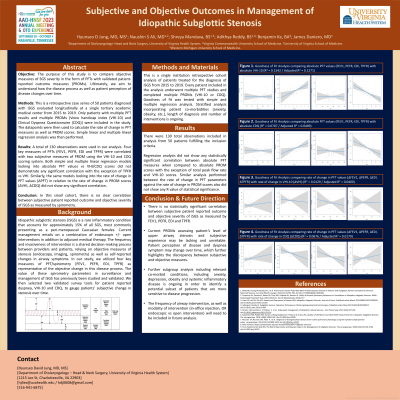Laryngology/Broncho-Esophagology
(462) Subjective and objective outcomes in management of idiopathic subglottic stenosis
Monday, October 2, 2023
2:45 PM - 3:45 PM East Coast USA Time

Has Audio

Hyun Seo Jung, MD, MS
Resident Physician
University of Virginia
Charlottesville, Virginia, United States
James J. Daniero, MD MS
Associate Professor
University of Virginia
Charlottesville, VA, United States
Presenting Author(s)
Senior Author(s)
Introduction: The purpose of this study is to compare the subjective and objective outcome measures in patients with Idiopathic Subglottic stenosis (iSGS) by utilizing pulmonary function tests and patient reported outcome measures (PROM). Ultimately, we aim to identify patient characteristics that contribute to any correlation or discrepancy between subjective and objective outcome in iSGS patients.
Methods: This is a retrospective case series of 50 patients with iSGS in a single tertiary academic center managed between 2015 and 2022. Each patient underwent multiple pulmonary function testing as well as survey questionnaires (VHI-10 & CDQ). Then four spirometry measures - FEV1, PEFR, EDI and TPFR - were correlated with PROM scores. Multiple linear regression was performed. Secondary analysis was performed after stratifying population with co-morbid anxiety, depression, BMI , length of iSGS diagnosis, types of intervention as well as frequency of intervention. Multivariate analyses were performed.
Results: A total of 130 total observations were used in our analysis. Multiple linear regression models showed no significant correlation between PFT parameters and PROM scores with the exception of TPFR vs. VHI-10 scores. Stratified multivariate analyses looking into co-morbid factors showed association with anxiety, BMI and length of diagnosis, although these findings were not statistically significant (p < 0.05).
Conclusions: The results of the study demonstrates no significant correlation between spirometry measures and PROM scores as measured with VHI-10 and CDQ. However, the presence of association, despite lack of statistical significance, with co-morbid anxiety, BMI and length of diagnosis shows that there are factors that potentially affect the correlation between the objective and subjective outcome measures. These findings suggest that patient perception of disease severity may change over time and that certain patients have a more sensitive perception of disease progression. Further studies are needed elucidate these factors and potentially affect the shared decision making process in treating iSGS .
Methods: This is a retrospective case series of 50 patients with iSGS in a single tertiary academic center managed between 2015 and 2022. Each patient underwent multiple pulmonary function testing as well as survey questionnaires (VHI-10 & CDQ). Then four spirometry measures - FEV1, PEFR, EDI and TPFR - were correlated with PROM scores. Multiple linear regression was performed. Secondary analysis was performed after stratifying population with co-morbid anxiety, depression, BMI , length of iSGS diagnosis, types of intervention as well as frequency of intervention. Multivariate analyses were performed.
Results: A total of 130 total observations were used in our analysis. Multiple linear regression models showed no significant correlation between PFT parameters and PROM scores with the exception of TPFR vs. VHI-10 scores. Stratified multivariate analyses looking into co-morbid factors showed association with anxiety, BMI and length of diagnosis, although these findings were not statistically significant (p < 0.05).
Conclusions: The results of the study demonstrates no significant correlation between spirometry measures and PROM scores as measured with VHI-10 and CDQ. However, the presence of association, despite lack of statistical significance, with co-morbid anxiety, BMI and length of diagnosis shows that there are factors that potentially affect the correlation between the objective and subjective outcome measures. These findings suggest that patient perception of disease severity may change over time and that certain patients have a more sensitive perception of disease progression. Further studies are needed elucidate these factors and potentially affect the shared decision making process in treating iSGS .
